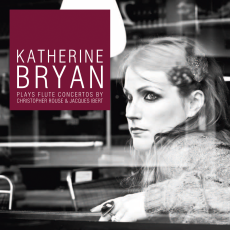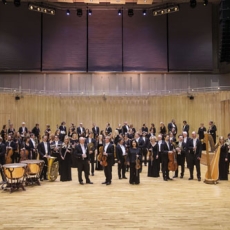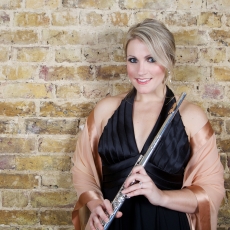Katherine Bryan - Katherine Bryan plays Flute Concertos by Christopher Rouse and Jacques Ibert - Maestro Steve
Katherine Bryan is the principal flautist with the Royal Scottish National Orchestra. She debuted at the age of 15 with the Academy of St. Martin-in-the-Fields and appeared for the first time in the US with the Juilliard Orchestra. A much lauded performer, she more recently also released her debut solo recording featuring a program of Nielsen, Liebermann, and Poulenc. This blend of standard flute repertoire with newer works is certainly most commendable and is on display in this latest release recorded in 2012. Here we have two smaller works by Debussy and Martin that serve as encores/fillers coupled with a classic repertoire work and a newer addition to the flute repertoire.
Christopher Rouse's music generally garners some attention and his concerti tend to be fascinating works. The 1993 Flute Concerto was written for Carol Wincenc who recorded it with the Houston Symphony on Telarc. The work was composed as a response to a story about a murdered 2-year old from Liverpool. Considered perhaps to be one of the great flute works from the end of the past century, it certainly is an audience-pleasing and accessible work. The three inner movements are bookended by outer movements labeled 'Amhran' - 'song' in Gaelic. The first opens with solo flute in a beautiful lyrical melodic idea featuring subdued harmonic support in the strings. The calm is shattered by the 'Alla Marcia', a lively work which perhaps is also a more intense response to the work's inspiration. The central 'Elegia' is the work's heart. It's length the equivalent of the outer two movements on either side. It opens with a lyrical bassoon solo soon handed over to the flute which returns with a more elaborate reminiscence of the opening song-like material. Here the string harmonies tend to add slight punctuations to these lines as Rouse focuses now on intriguing writing for woodwinds. The piece presents these ideas in slight alternation with the strings tending to appear in hymn-like responses. The movement grows in intensity as it moves to its final bars with a huge orchestral crescendo and addition of brass. Of all the movements, this one sometimes makes you forget this is a 'concerto' as it is so masterfully constructed. The 'Scherzo' is cast like a jig and as the previous movement's intensity came from the addition of sections of the orchestra, this movement's focus is on tempo with a frenzied solo against an ensemble that is equally unnerved. It is the most like the composer's earlier works. The Irish melodic content in its final bars is quite striking after all that has gone before and the solo line then moves beautifully into the final 'Amhran' movement as we come full circle. It is simply an amazing piece of work.
Jacques Ibert's 1933 Concerto is perhaps among the most popular contemporary works for the instrument. Ibert's wit is certainly on display in this piece written for the French flautist Marcel Moyse. The final movement would become a test piece at the Conservatoire. The works technical challenges would keep it off programs in the U.S. and England until 1948. The opening rush of 16ths from the beginning signal the technical demands both for the soloist and orchestra. The energy certainly leaves one breathless. Along the way are many characteristic touches of delightful orchestration and jazzy rhythmic influences, especially in its final movement. The central slow movement shifts to a more reflective atmosphere making a perfect contrast to the outer movements.
The smaller pieces are also standard repertoire works. The first, Debussy's Syrinx (1913), is an essential piece to get under one's fingers for every flautist and is the quintessential flute solo. The concluding work is Frank Martin's Ballade (1939). Martin's music is lesser known but his work for solo instruments tends to appear often in recital programs. During the period of this work, he was in the midst of composing several ballades highlighting different solo instruments. Martin was experimenting in this period with different styles. He is more noted as a composer of Neo-Classical music, but his recent exposure to Schoenberg's twelve-tone system impacted this work. While one can discern some of this Schoenberg influence in the piece, it still maintains a link to Martin's more tonal pieces. The solo line makes complete use of the flute's register, with a striking section for its lowest end. Lyrical ideas are alternated with those of angular harmonic leaps. It makes for an intriguing work. Originally cast for flute and piano, this particular piece would eventually be orchestrated...
Bryan's performance of the central 'Elegia' movement clocks in almost a minute and a half shorter than Wincenc's Telarc recording. However, her interpretation is equally valid throughout and the orchestral accompaniment, captured in Linn's sonic splendor, is simply amazing to hear. Other movements tend to be fairly close to Wincenc's, though you will certainly want to hear both at some point. Flute aficionados will all have their favorite recorded performances of this piece. The third movement of the Ibert is a minute longer than Emmanuel Pahud's fine 2003 EMI recording. The key here though to include a familiar work among a newer concerto and a couple of smaller pieces is what makes this CD quite recommendable.
The Royal Scottish National Orchestra continues to build on an already stellar catalogue of recorded music with this new release. Linn Records' hybrid SACD release is crystal clear allowing large climaxes to work very well. The imaging of the soloist against the orchestra is quite amazing as well and very well-captured in the Debussy. Highly recommended!


